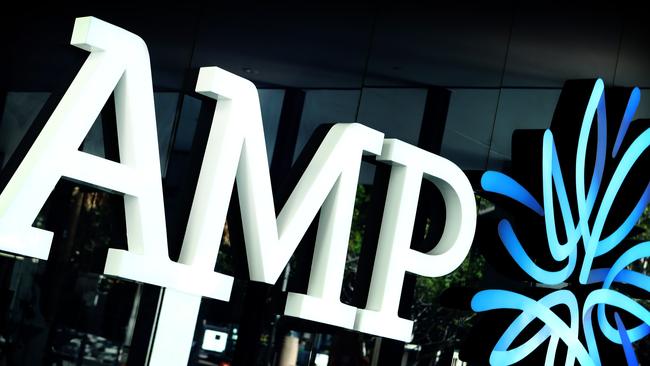AMP rattled as life sale fails
The breakdown of AMP’s $3.3 billion sale of its life business has left its turnaround strategy in tatters.

The breakdown of AMP’s $3.3 billion sale of its life business has left its turnaround strategy in tatters, amid warnings the embattled wealth manager needs to move fast to resuscitate a deal due to pressure on its balance sheet and risks to its dividend.
AMP yesterday revealed that the Reserve Bank of New Zealand would not back the sale of its life business to Sir Clive Cowdery’s Resolution Life business unless the UK acquirer agreed to “ring-fence” certain assets to benefit New Zealand policyholders.
Both AMP and Resolution were working to rescue the deal, but it is expected to come at a significant cost to the original price tag.
“The transaction for the sale of AMP Life to Resolution Life is highly unlikely to proceed on the current terms,” AMP warned yesterday, in a move that triggered a 15.8 per cent share plunge.
Addressing the RBNZ’s requirements would “adversely impact the commercial return of the sale for both AMP and Resolution Life,” AMP added.
The deal revelations and an axing of AMP’s interim dividend spooked investors and had some analysts pencilling in a capital raising to shore up its balance sheet.
The financial services company said it was working with Resolution to rescue the deal but warned that the value of the assets had deteriorated by $700 million since the original agreement was signed in October last year.
AMP also told shareholders that uncertainty over the sale meant it would not pay a dividend when it reported its first-half results early next month.
The stock fell to all-time lows on the dim outlook for dividends and concerns over its capital position, closing down 15.81 per cent at $1.81, after earlier falling as low as $1.77.
In response to AMP’s update, Resolution reaffirmed its commitment to the deal, saying it viewed the acquisition as “an excellent opportunity”.
“As such, the two parties are now engaged in discussions regarding a restructuring of the transaction (including updated terms) to accommodate the regulatory requirements,” Resolution said last night.
Allan Gray managing director Simon Mawhinney, who was highly critical of the original deal and whose firm owns about 3 per cent of AMP, said he was “reasonably pleased” with the news that the deal might not go ahead.
A better outcome would be for AMP to spin out the life insurance business through an in specie distribution to investors, rather than renegotiating the sale at a lower price, he said.
“I would be very, very concerned if this sale was back-engineered to ensure smooth passage,” Mr Mawhinney added.
“That would be the most disastrous path forward.”
Morningstar equity analyst Chanaka Gunasekera, who described AMP’s update as “pretty awful news”, was not convinced the sale would go ahead.
“The most likely outcome now is they’re not going to be able to sell this business … and even if they are going to sell it, it would have to be much cheaper than previously,” he told The Australian.
“I suspect they may now have to keep hold of the life division; it’s put their strategy right up in the air. And given the higher capital requirements, it’s also going to impact on their dividend,” he warned.
The RBNZ, meanwhile, said it “remains engaged” with both AMP and Resolution and that in considering the deal, it “maintained a clear focus on the interest of policyholders”.
“The contract between the AMP Life NZ and Resolution Life was agreed without consideration of the Reserve Bank’s requirements. The Reserve Bank continues to constructively engage with both parties, and will continue to have full regard for its responsibilities as regulator,” RBNZ deputy governor Geoff Bascand said.
Regal Funds Management portfolio manager Mark Nathan said the RBNZ wasn’t asking for anything unreasonable and that AMP and Resolution should have explored the potential regulatory implications.
“They [AMP] need to resolve this. I think the most likely outcome is they strike a deal with Resolution on terms that are not as good,” he said.
The sale of its life business was just one of a number of actions AMP took to rescue the brand following damning revelations at the banking royal commission.
At the time it was announced, in November last year, AMP faced heavy criticism from shareholders who argued it undervalued the assets and said the sale should have been put to a vote.
But Shaw and Partners banking analyst Brett Le Mesurier said proceeding with a sale was still the best option for AMP and that spinning off the business was an unlikely scenario.
“They should be so lucky that there would be a market for [a spin-off],” he said. “They need to get a deal done [with Resolution] … to stop this business, which is earning very little, requiring additional capital. It makes no sense to retain a business like that.”
Mr Mawhinney said a capital raising was contingent on a lot of assumptions. “You would hope sufficient capital is maintained to help them navigate the way forward,” he said.
Macquarie analysts yesterday warned that AMP’s failure to pay a dividend highlighted its stretched capital position and they saw a “heightened risk” that it would be forced to raise capital to strengthen its balance sheet.
“We expect AMP to increase their advice remediation provisions (around $400m in our valuation), which could be the catalyst for such a raising,” the analysts said in a note to clients.




To join the conversation, please log in. Don't have an account? Register
Join the conversation, you are commenting as Logout